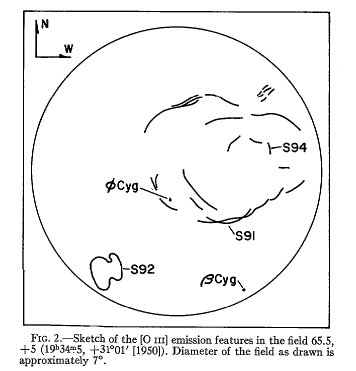
That is one reason it is particularly exciting to find a new supernova remnant, this one only a few degrees from Albireo. The long, thin thread of light that Steve and I observed at RA 19 39.7 DEC +29 57 is brighter and easier than anything that I have observed (or tried to observe) in Simeis 147. Let us know if you observe any other filaments in this giant supernova ring. - Jim Shields

17.5" (7/22/01): viewed at 64x with OIII filter. Appeared as a faint, thin wisp ~8'x0.5', appearing to dangle from mag 8.5 HD 185735 and oriented WSW-ENE. The filament also passes through a mag 11 star 4' NW. Fairly easy with an unusual appearance with averted vision.
17.5" (7/17/01): Picked up this HII strip or possible supernova remnant at 64x (31 Nagler) using an OIII filter. Appeared as a very faint, long filament of nebulosity starting north of a mag 9 star and trailing NE for ~6-7'. The strip is at most 1' in width and seems slightly bowed out to the south away from mag 4.7 Phi Cygni 14' N. Nebulosity was suspected continuing just west of the mag 8 star (V2086). For such an obscure object, the observation was surprisingly easy. This is the brightest strip of SNR G65.3+5.7, which spans some 4 X 3.3 degrees and was discovered in 1997. - Steve Gottlieb
But, is Sharpless 2-91 a supernova remnant? That's the question that came to mind as I looked at my observing notes this morning. The SIMBAD site classifies both Sh2-91 and LBN 147 as HII regions... a little time spent browsing the online databases answered my question and yielded a couple of surprises. Looking at D. Green's "A Catalogue of Galactic Supernova Remnants" gave the information I was seeking -- yes, Sh2-91 (the remnant G65.3+5.7) is indeed the debris of a dead star.
 The small part of the nebula I observed is
the brightest part (in [OIII] light) of shell measuring 4 degrees by 3.3
degrees (PA ~95 degrees) according to paper written by Gull, Kirschner &
Parker. Their "Emission-Line Survey of the Milky Way" atlas contains an
[OIII] image suggesting there are many nebulae in the area that may be of
interest to observers. Sh2-94 (LBN 148) should be properly considered as a
part of the remnant although it appears to be much fainter than the Sh2-91
shred. Perhaps a close look at this region will yield some visual surprises
to the keen observer! - Dave Riddle
The small part of the nebula I observed is
the brightest part (in [OIII] light) of shell measuring 4 degrees by 3.3
degrees (PA ~95 degrees) according to paper written by Gull, Kirschner &
Parker. Their "Emission-Line Survey of the Milky Way" atlas contains an
[OIII] image suggesting there are many nebulae in the area that may be of
interest to observers. Sh2-94 (LBN 148) should be properly considered as a
part of the remnant although it appears to be much fainter than the Sh2-91
shred. Perhaps a close look at this region will yield some visual surprises
to the keen observer! - Dave Riddle
Sharpless 91 indeed is a very fine object. It has been a long time favorite of mine. The following text compromises my observations:
"This is a most beautiful object, splendid to discover in a warm summer night. The faint filaments of this SNR cover an area almost 4° in diameter, some 2° northeast of Albireo. There are five narrow filaments suitable for visual observation:
(1) 19h 34.2min 29° 37' S 91
(2) 19h 35.3min 30° 05' S 91
(3) 19h 39.7min 29° 58' S 91
(4) 19h 41.2min 32° 11' S 94
(5) 19h 42.6min 31° 48' S 94
Part (3) is by far the easiest of all. It is definitely visible in a 6" equipped with [OIII] filter. A 20" under a superb mag 7.2 alpine sky shows a bright streak of nebulosity some 25' long and not more than 2' wide, running past two bright stars just south of 12 Cygni. It displays a bright edge to the southeast along its trail. All other parts of the nebula are real challenges for visual observers. (2) was faintly visible with the 20" on the same occasion. All other parts are not visible with a 14", S 94 appears faintly in an 18" and [OIII] filter. " - Ronald Stoyan
